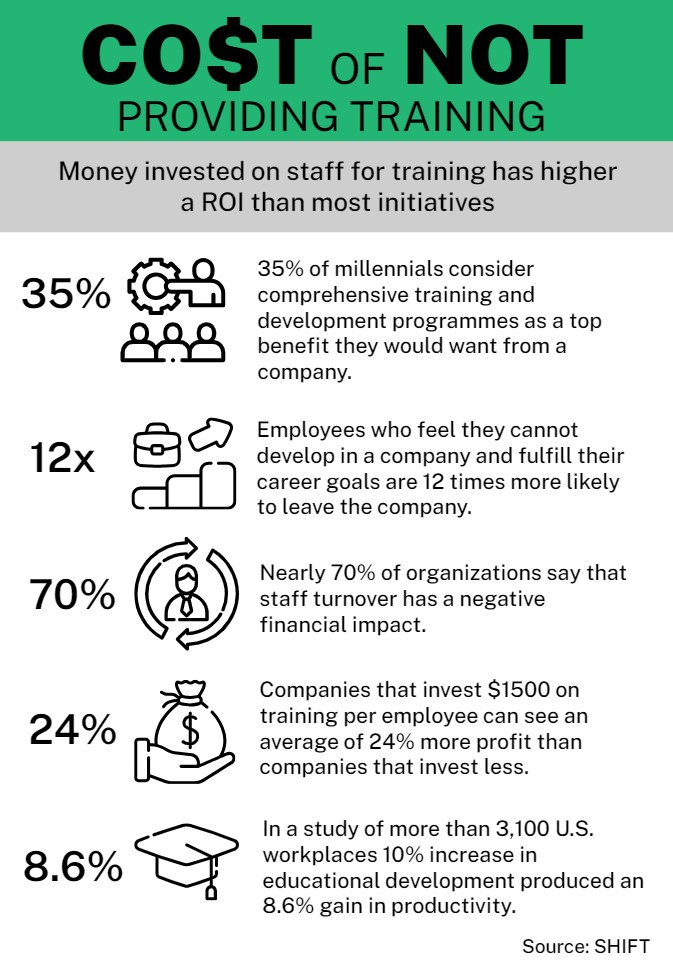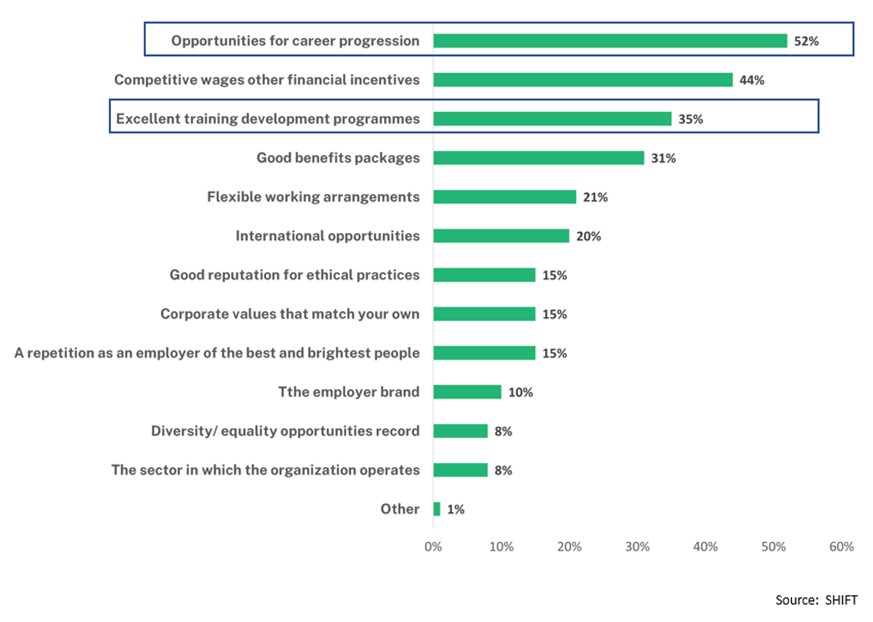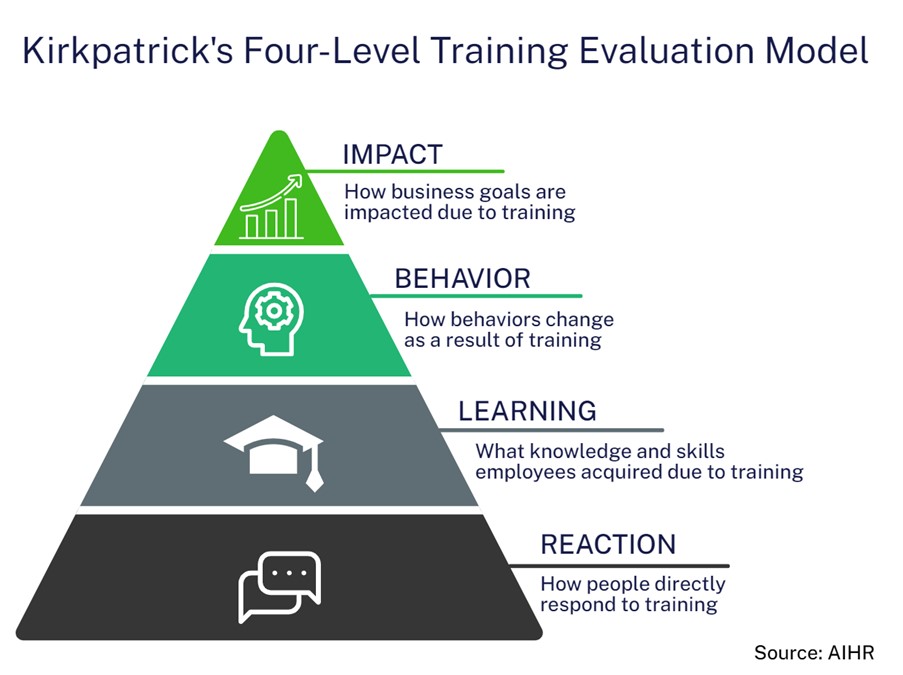
The Business Research Company’s 2023 report unveils a powerful surge in the global corporate training and development market, skyrocketing to an astounding $460.04 billion by 2027, propelled by a robust 4.8% CAGR.
Have you ever felt like you're constantly battling against the flow, with every new challenge pushing you farther from success? In today's fast-paced business landscape, it is not uncommon for leaders to face a constant uphill battle. Technology can be a powerful solution to boost your productivity and competitiveness. Conversely, it can pose various challenges, such as skill gaps, security risks, or compatibility issues. To harness its full potential, you and your team must be well-equipped with the right skill sets. That is why investing in effective training and development is crucial.
Business leaders play a pivotal role in setting the vision, motivating the team, and overseeing the execution of the strategy. But leadership is no walk in the park. Leaders need to constantly adapt, learn, and improve their skills to stay ahead of the curve and deliver results. In this article, we will explore the significance of training and development for business leaders and the common workforce, addressing workforce productivity challenges, and strategies for their implementation.
The Evolving Business Landscape
In the ever-evolving business environment of today, the keys to unlocking productivity lie in adaptability and technological prowess. A forward-looking report by the World Economic Forum anticipates that automation will take over more than half of all workplace tasks by 2025, thereby redefining job roles. This highlights the critical need for leaders and employees who are not only adaptable but also well-trained. As per the Association for Talent Development, organizations that foster robust learning cultures have a 46% higher likelihood of being industry leaders.
The Project Management Institute’s report unveils a shocking waste of $122 million for every billion dollars invested in the US, attributed to subpar project performance. In this rapidly evolving market, the adoption of advanced technologies has shifted from being a mere option to becoming the sole sustainable solution.
"If you believe that training is expensive, it is because you do not know what ignorance costs. Companies that have the loyalty of their employees invest heavily in permanent training programs and promotion systems."
- Michael Leboeuf, American Business Author
Continuous training and development are not just important, they’re indispensable. As the digital landscape evolves daily with the emergence of new technologies, it’s imperative for the workforce to continually upskill and adapt. Be it the fast-paced retail sector or the IT industry, where advanced solutions and AI technologies are integral to successful project execution. The absence of these skills not only hampers employee growth but also leads to organizational setbacks due to an unskilled workforce and productivity loss. Therefore, as business complexities escalate, a proficient and skilled workforce becomes increasingly vital.
Modern predictive intelligence solutions stand as the vanguard of transformative strategies, revolutionizing the realm of workforce training and development. By leveraging advanced algorithms and data analytics, these cutting-edge solutions not only forecast future trends but also optimize training programs with surgical precision. The impact is profound, reshaping the traditional approach to employee empowerment and productivity.
Organizations that harness the power of predictive intelligence in training and development witness a quantum leap in efficiency, as these solutions tailor learning experiences to individual needs, ensuring a workforce that is not only well-prepared for current challenges but also future-proofed against the evolving demands of the professional arena. In essence, the integration of predictive intelligence marks a pivotal paradigm shift, propelling businesses towards unprecedented levels of agility, innovation, and sustained excellence in training and development initiatives.
Reasons to Invest in Training and Development
- Enhanced productivity and performance - Training improves skills, knowledge, and confidence, leading to more efficient work.
- Standardized work processes - Training aligns employees on uniform procedures, promoting consistency.
- Reduced wastage - Training encourages efficient use of resources, minimizing waste.
- Decreased supervision - While not eliminating supervision, training reduces the need for constant oversight.
- Internal promotions - Training allows organizations to groom and promote existing staff with new skills.
- Improved organizational structure - Structured training prevents trial-and-error learning.
- Increased morale - Training fosters a supportive work environment, boosting employee confidence.
- Enhanced customer service - Training leads to improved professionalism, positively impacting customer perception.
- Improved workplace culture - Training creates a more effective and welcoming work atmosphere.
- Updated technology proficiency - Training keeps employees up-to-date with evolving technologies, increasing efficiency.
Importance of Management Skills
As a business leader, your skillsets are vital for your organization’s success. You need to constantly improve your abilities to grow and develop in any profession and across various initiatives. Some of the skills you should focus on are strategic thinking, innovation, collaboration, communication, and continuous learning which will make you a better leader. The IT industry has seen the effects of inadequate training and the constant need for upskilling over time. For example, a recent survey found that insufficient senior management involvement causes 33% of projects to fail, which shows the importance of skills like decision-making, risk management, stakeholder engagement, team building, and delegation. These skills help align teams with the organizational goals and drive results.
The cultivation of skills through training and development is advantageous not just for organizations, but also for employees. Indeed, a significant 88% of employees deem these skills as crucial, with 77% witnessing career progression as a direct outcome of upskilling initiatives. Moreover, the incorporation of contemporary solutions like analytical instruments or predictive insights can substantially amplify learning capacities and propel workforce productivity, thereby guaranteeing comprehensive success.

Identifying Training Needs
To optimize workplace productivity, investing in effective training and development is crucial. To identify your training needs, follow these steps:
- Assess current skills and performance - Evaluate using methods like self-assessment, feedback, performance reviews, or tests. Benchmark against industry or organizational standards. Utilize solutions like the Leadership Skills Assessment Solution for competency measurement.
- Identify skill gaps - Based on the assessment, pinpoint areas for improvement or new skills. Prioritize crucial skills. A McKinsey survey reveals that 87% of executives expect skill gaps, with common gaps in data analytics, IT management, and executive management.
- Link training to business goals - Relate training needs to business objectives. For example, improving communication and customer service skills enhances customer satisfaction. Learning about modern technologies supports innovation. The Association for Talent Development reports that aligning training with business goals leads to 50% higher net sales per employee.
- Tailoring Training Programs - Business leaders recognize the vital role of training in growth and performance. Not all programs suit your needs, so customization is key.
- Customize programs for leaders and employees - Select relevant, accurate, and up-to-date training that covers essential skills and topics for your field.
- Emphasize real-world scenarios - Choose programs with practical simulations to enhance problem-solving, decision-making, and critical thinking. LinkedIn Learning reports a 68% preference for work-related training.
- Integrate project management training - Opt for programs that include planning, organizing, executing, monitoring, and closing projects. The Project Management Institute reports 38% more successful projects, 33% fewer failures, and 27% higher customer satisfaction with such training.
A survey by PwC that interviewed 10,000 employees globally found that training and development opportunities ranked highly among characteristics that make an organization appealing to work for.

Measuring Success
As a business leader, you must recognize the value of training and development. To assess your progress, employ these methods and metrics:
- Self-assessment - Use questionnaires or self-assessment solutions to gauge your skills and compare them with program objectives, e.g., the Kirkpatrick Model (a widely recognized model for evaluating training effectiveness).
- External feedback - Seek input from peers, superiors, clients, or mentors through ratings or qualitative comments, employing methods like 360-degree feedback.
- Performance metrics - Utilize quantifiable indicators (e.g., sales, customer satisfaction, productivity, project outcomes) to track changes before and after training. Calculate ROI to assess cost-effectiveness.
- Testing - Take exams to measure knowledge acquisition and compare scores against program benchmarks, possibly earning certifications.

Best Practices for Training and Development Initiatives
To enhance workplace productivity and support employee growth, follow these proven strategies:
- Strategic Planning - Before starting any program, set clear goals and allocate resources. Companies that plan their training have 46% higher net sales per employee (Association for Talent Development).
- Active Engagement - Be proactive during training. Actively participate, ask questions, and apply what you learn. Proactive learners retain 21% more skills (Harvard Business Review).
- Review and Reflect - After training, assess your progress, and identify gaps and areas for improvement. Reflecting on learning leads to 23% higher skill transfer (University of Texas at Austin).
- Sustained Learning - Follow up with regular practice, reinforcement, and feedback. Applying new skills to new challenges results in 18% higher skill performance (University of Waterloo).
Use Cases - Leader Training Success Stories
Business leaders seeking improved productivity and skills can draw inspiration from successful companies:
Google Training and Development Programs
- Project Oxygen: 10% improvement in manager quality and a 9% increase in employee retention.
- Project Aristotle: Improved team performance by 25% and innovation by 38%.
- Manager Development: Increased employee engagement by 12% and productivity by 10%.
Starbucks Training and Development Programs
- Leadership Lab: 15% boost in employee engagement, 10% rise in customer satisfaction, and an 8% sales growth.
- Leadership Excellence Series: Improved employee retention by 20%, performance by 15%, and development by 10%.
- Leadership Immersion: Increased leader empathy by 30%, awareness by 25%, and action by 20%.
IBM Training and Development Programs
- IBM Leadership Academy: Increased leader effectiveness by 40%, engagement by 35%, and retention by 30%.
- Project Management Center of Excellence: Improved project success rates by 50%, quality by 40%, and efficiency by 30%.
- IBM Watson Academy: Increased leader innovation by 45%, insight by 40%, and impact by 35%.
Training is an investment that pays off in terms of productivity, innovation, and competitiveness. Organizations can learn from these success stories and apply the insights to their training programs, to see how training improves productivity and performance. Training helps employees understand their responsibilities better and acquire the knowledge and skills they need to do their job, which boosts their confidence and performance.
Companies must go beyond imparting foundational skills to their workforce; it’s crucial to integrate advanced AI and analytical solutions into their training. This not only fosters a workforce proficient in leveraging real-time insights but also positions them as proactive problem solvers, capable of anticipating issues before they arise.
The vision for the future transcends traditional training, embracing a dynamic approach to predictive intelligence. By infusing AI-driven analytics into their training programs, companies equip their workforce to foresee challenges and act preemptively, fostering a culture of resilience and agility. This forward-thinking strategy not only sharpens employees’ ability to tackle present complexities but also prepares them for future challenges.
To optimize the impact of these training initiatives, organizations must emphasize consistency and continuity. Regular training experiences, smoothly integrated into the professional journey, not only reinforce skills but also adapt to the industry’s evolving demands. This dedication to continuous learning nurtures a workforce that excels in the present and actively shapes the future, aligning perfectly with the organization’s vision for enduring success and innovation.
Conclusion
Training and development are crucial for equipping an organization to tackle future challenges and keep pace with technological advancements. A well-structured and regularly updated training plan is essential for all levels of the workforce. By investing in modern solutions and solutions for training, companies can enhance their employees’ knowledge and skills, leading to improved outcomes. This investment not only enhances leadership and project management skills but also fosters better decision-making, problem-solving, communication, and collaboration.
Amplifying workforce learning capabilities, TrueProject emerges as a groundbreaking solution. Building on training foundations, this predictive intelligence solution significantly escalates productivity. It harnesses data-driven insights and predictive analytics to refine project management, optimize resource allocation, and preemptively tackle challenges. This proactive stance empowers leaders to make informed decisions, enhancing project management skills. Consequently, businesses consistently achieve successful outcomes, boosting workforce productivity and performance. The smooth transition from training to TrueProject application fosters a holistic development approach, cultivating a proactive workforce.
More information about TrueProject on trueprojectinsight.com
About the Author:
Priyanka Chakraborty is a trailblazer in project leadership, content creation, and marketing with a career spanning over a decade. Priyanka has a versatile skill set and unwavering commitment to excellence. She has seamlessly navigated through content editing, graphic design, video creation, and now serves as a powerhouse Senior Manager overseeing marketing projects. Priyanka's prowess extends beyond content – she orchestrates marketing projects with finesse, driving campaigns to success. Her knack for stakeholder management and project coordination sets her apart as a true leader. Beyond the office, Priyanka immerses herself in literature, paints her imagination onto canvases, and finds rhythm in music.
Endnotes
- Diana Cohen. “The True Cost of Not Providing Employee Training.” Shift: (n.d.) https://www.shiftelearning.com/blog/the-true-cost-of-not-providing-employee-training
- Michael Keenan. “7 Best Practices for an Effective Learning and Development Program.” WorkRamp: November 02, 2022.https://www.workramp.com/blog/improve-your-learning-and-development-program/
- Shera Bariuad. “Best Practices in Training and Development.” EdApp: October 06, 2021.https://www.edapp.com/blog/best-practices-in-training-and-development/
- Forbes Councils Member. “12 Ways To Implement Successful Employee Training Initiatives.” Forbes: July 13, 2021. https://www.forbes.com/sites/forbeshumanresourcescouncil/2021/07/13/12-ways-to-implement-successful-employee-training-initiatives/?sh=1cb70ced4a8a
- Empxtrack Team. “Not Investing in Employee Training & Development? Your Business is Already at Risk!” Empxtrack: (n.d.) https://empxtrack.com/blog/not-investing-in-employee-training-development-your-business-is-already-at-risk/
- Mark Langley. “Success Rates Rise.” Project Management Institute: (2017) https://www.pmi.org/-/media/pmi/documents/public/pdf/learning/thought-leadership/pulse/pulse-of-the-profession-2017.pdf
- Baysa.io. “Project Oxygen - What can we learn from the way Google train their managers?” LinkedIn: March 22, 2023. https://www.linkedin.com/pulse/project-oxygen-what-can-we-learn-from-way-google-train-managers/
- Shani Jay. “Measuring Training Effectiveness: A Practical Guide.” Academy to Innovate HR: (n.d.) “https://www.aihr.com/blog/measuring-training-effectiveness/





